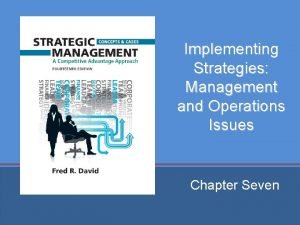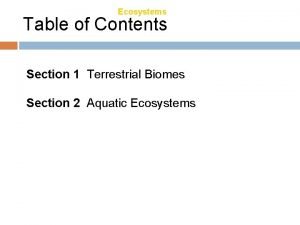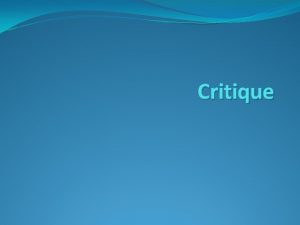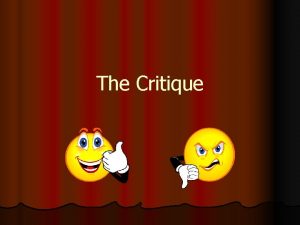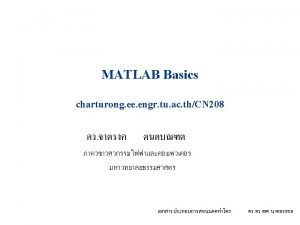Critique Format A critique is written largely like






- Slides: 6

Critique

Format � A critique is written largely like any other essay. However, it does have some specifics that some other essays don’t. � Introduction: � Begin with a summary of the text you are critiquing. In a few sentences, relate the main argument of the text. � Move on to thesis. In order to avoid a jarring shift between the summary and thesis, use a transitional expression. Note that thesis judges the quality of the work by labeling it credible or non-credible. Body: The body, as in other essays, supports thesis, using reasoning as well as evidence from the text being critiqued. Remember you are trying arguing whether the text is credible or not, not defending or opposing the idea the text presents. Conclusion: As with other essays, the conclusion echoes the introduction and brings the essay to a close.

Example Introduction: � In the newspaper article “Study Casts Doubt on Abstinence-Only Programs, ” written by Laura Sessions Stepp, Stepp concludes that abstinence-only programs do not keep teenagers from being sexually active. Stepp backs up this argument by including a study following 2, 000 children from elementary or middle school into high school. These children lived in four communities and slightly more than half of them received abstinence-only education. “By the end of the study, when the average child was just shy of 17, half of both groups of teenagers had remained abstinent” (Stepp) proving that the abstinence-only programs had little to no effect on whether or not the children had sex. Stepp definitely provides a credible argument because she includes many facts, recorded experiments and studies, and experts’ opinions while defending her case. � Green=summary � Red= thesis

Example Body Paragraph: � Another reason why Stepp provides a credible argument is because she uses experts in relevant fields of professions to deliver commentary on the results of the study. She quotes many different people including Sarah Brown, executive director of the National Campaign to Prevent Teen Pregnancy, and Harry Wilson, a top official in the Department of Health and Human Services to help clarify the results of the study and to explain what the results mean in regards to the progress of preventing teen pregnancy. After learning the results of the study, Sarah Brown says “There’s not a lot of good news here for people who pin their hopes on abstinence-only education. ” By including this quote by an expert instead of commenting herself, Stepp confirms credibility with her evidence and leaves out any threat of using false authority by making a conclusion without the prior experience necessary to make such a statement. � Green=topic sentence � Blue=evidence � Purple=commentary

Example Conclusion: �In conclusion, Stepp makes a credible argument when she concludes that abstinence-only programs are not effective and do not stop teenagers from being sexually active. Stepp uses many facts and trustworthy information when she makes her proclamations and she leaves out any logical fallacies, ambiguity, and assumptions. Stepp definitely provides relevant, reliable, specific, and sufficient information when she argues for her declaration. All in all, Laura Sessions Stepp does a great job concluding that abstinenceonly programs are ineffective.

